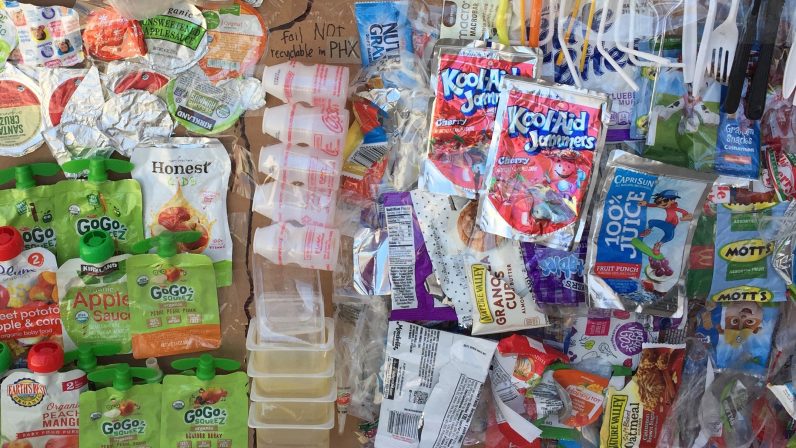This photo may seem familiar to some of you. It’s a closeup of one week’s lunch trash we collected last spring. I thought it was worth revisiting. Each September we devote two weeks to our all-school nutrition study. What started as a teacher conversation about developmentally appropriate food practices with young children evolved into a website (seedfood) and an annual tradition.
Each class approaches the two-week study in a way that is developmentally suited to the age group. Toddler students engage in food explorations with all their senses, as they touch, taste, smell, observe with eyes and ears, cook, and compare the bounty before them. Preschoolers do the same, and add activities such as food surveys, identification of different food groups, sorting and classifying, gardening, and talking about recipes. Elementary students learn about food labels and hidden ingredients, use technology to graph lunch contents, talk about family recipes and the importance of food in all cultures, and discuss the significance of making healthy food choices.
As students and teachers broaden their knowledge about food, we also like to offer tips and resources to parents. This year’s tips are related to reducing the amount of throwaway plastics in children’s lunches. Over the years, Seed parents have become exceptionally diligent about using reusable containers, eliminating Lunchables, reducing the use of single use water bottles, and sending in reusable utensils. For that, we applaud you and invite you to keep at it. If you’re not quite there yet (but want to be), or need a refresher, here are a few suggestions for reducing your child’s lunch trash:
- use small reusable containers for items like yogurt, pudding, or applesauce instead of buying single servings (this will save you money)
- purchase larger blocks of cheese (or bags of multiples) and cut into smaller chunks for lunches (this will save you money)
- make your own bars, muffins, cookies or buy larger packages instead of single servings that all have plastic wrappers
- include reusable utensils, cloth napkins, reusable straw in your child’s lunchbox
- make your own smoothies instead of using the convenient pouches (these are difficult to recycle and are terrible for the environment)
- use reusable containers instead of plastic bags
We understand that some of these suggestions are more time consuming and may not be feasible for your family. In that case, maybe try one or two; if you do, you’ll be well on your way to helping reduce plastic trash on our planet. Let us know how we can help you implement more earth-friendly practices around your child’s lunches. For more history of the Seed’s nutrition study, check out these links:

